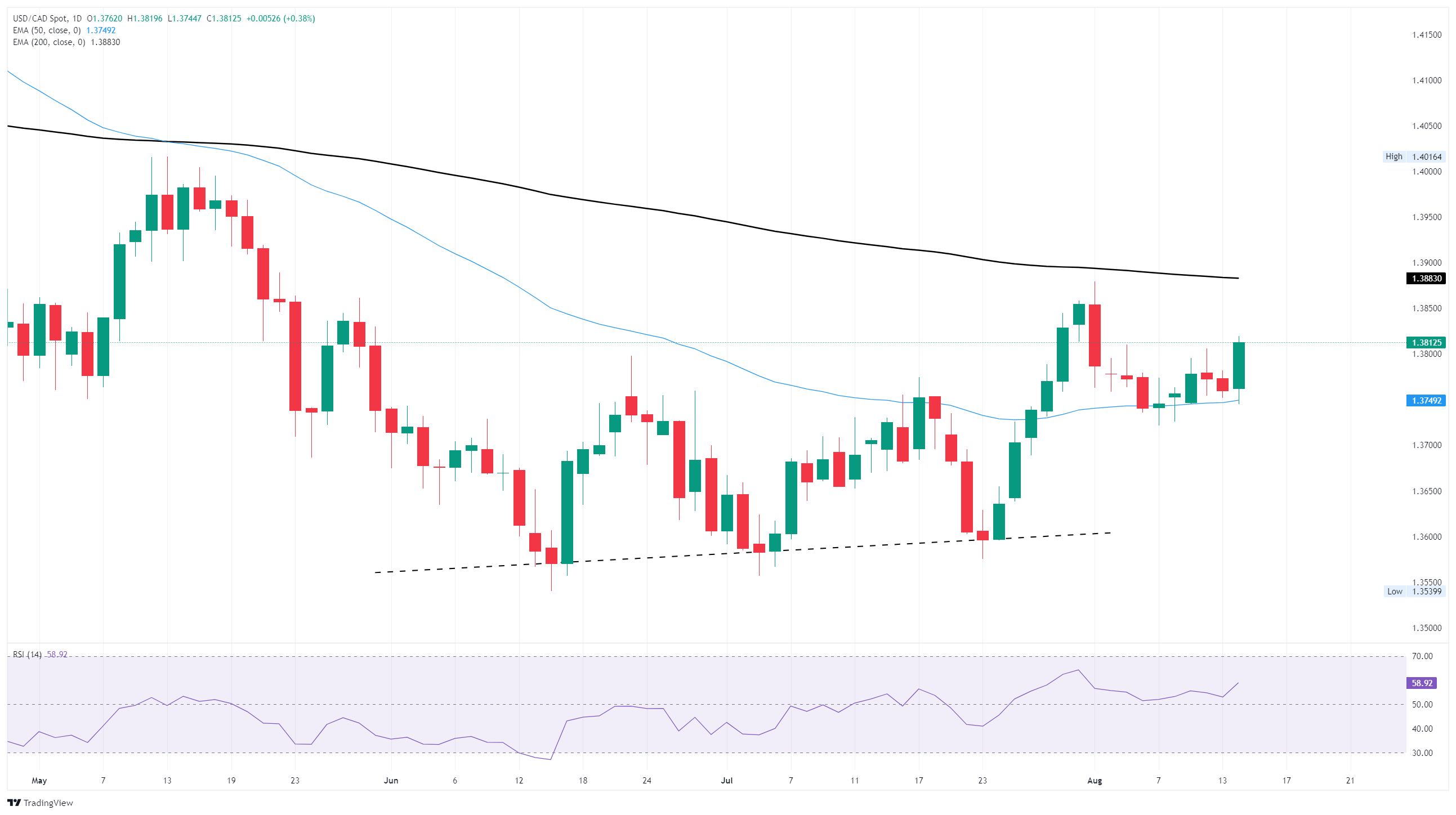- The Canadian Dollar tumbled over 0.5% against the Greenback on Thursday.
- A sharp jump in US PPI inflation figures sparked a safe-haven retreat into the US Dollar.
- Rising inflation knocked back Fed rate cut bets, but not by much.
The Canadian Dollar (CAD) took a step lower on Thursday, driven down by a broad-market upswing in the US Dollar (USD). United States (US) Producer Price Index (PPI) inflation for July was the key driving headline, trimming bets of when the Federal Reserve’s (Fed) next rate-cutting cycle would begin.
Canadian economic releases still remain almost entirely absent from the data docket this week, leaving Greenback flows firmly in the driver’s seat. The Bank of Canada’s (BoC) latest meeting minutes showed the Canadian central bank begrudgingly admit the Canadian economy may not be in a place that requires further rate cuts. This comes after the BoC’s latest rate cut sparked a jump in Canadian bond yields and mortgage prices.
Daily digest market movers: Canadian Dollar recedes on fresh Greenback strength
- The Canadian Dollar fell one-half of one percent against the US Dollar on Thursday.
- The USD/CAD pair has been bolstered back above the 1.3800 handle after almost two weeks of consolidation.
- US PPI inflation soared to 3.3% YoY in July, with core PPI inflation reaching a scorching 3.7% after sinking to just 2.6% in the previous period.
- Investors are once again concerned about US inflation pressures, but not enough to give up on a September Fed rate cut.
- Interest rate traders are still pricing in over 90% odds of a Fed interest rate cut on September 17, but now only see better-than-even odds of two rate cuts through the remainder of 2025, not three.
Canadian Dollar price forecast
Newfound Greenback strength has pushed the Canadian Dollar firmly onto the back foot, with USD/CAD once again trading above 1.3800. The pair is still caught in no-man’s land between the 50-day and 200-day Exponential Moving Averages (EMA), though little technical resistance lies between price action and 12-week highs above 1.3900.
USD/CAD daily chart

Canadian Dollar FAQs
The key factors driving the Canadian Dollar (CAD) are the level of interest rates set by the Bank of Canada (BoC), the price of Oil, Canada’s largest export, the health of its economy, inflation and the Trade Balance, which is the difference between the value of Canada’s exports versus its imports. Other factors include market sentiment – whether investors are taking on more risky assets (risk-on) or seeking safe-havens (risk-off) – with risk-on being CAD-positive. As its largest trading partner, the health of the US economy is also a key factor influencing the Canadian Dollar.
The Bank of Canada (BoC) has a significant influence on the Canadian Dollar by setting the level of interest rates that banks can lend to one another. This influences the level of interest rates for everyone. The main goal of the BoC is to maintain inflation at 1-3% by adjusting interest rates up or down. Relatively higher interest rates tend to be positive for the CAD. The Bank of Canada can also use quantitative easing and tightening to influence credit conditions, with the former CAD-negative and the latter CAD-positive.
The price of Oil is a key factor impacting the value of the Canadian Dollar. Petroleum is Canada’s biggest export, so Oil price tends to have an immediate impact on the CAD value. Generally, if Oil price rises CAD also goes up, as aggregate demand for the currency increases. The opposite is the case if the price of Oil falls. Higher Oil prices also tend to result in a greater likelihood of a positive Trade Balance, which is also supportive of the CAD.
While inflation had always traditionally been thought of as a negative factor for a currency since it lowers the value of money, the opposite has actually been the case in modern times with the relaxation of cross-border capital controls. Higher inflation tends to lead central banks to put up interest rates which attracts more capital inflows from global investors seeking a lucrative place to keep their money. This increases demand for the local currency, which in Canada’s case is the Canadian Dollar.
Macroeconomic data releases gauge the health of the economy and can have an impact on the Canadian Dollar. Indicators such as GDP, Manufacturing and Services PMIs, employment, and consumer sentiment surveys can all influence the direction of the CAD. A strong economy is good for the Canadian Dollar. Not only does it attract more foreign investment but it may encourage the Bank of Canada to put up interest rates, leading to a stronger currency. If economic data is weak, however, the CAD is likely to fall.






